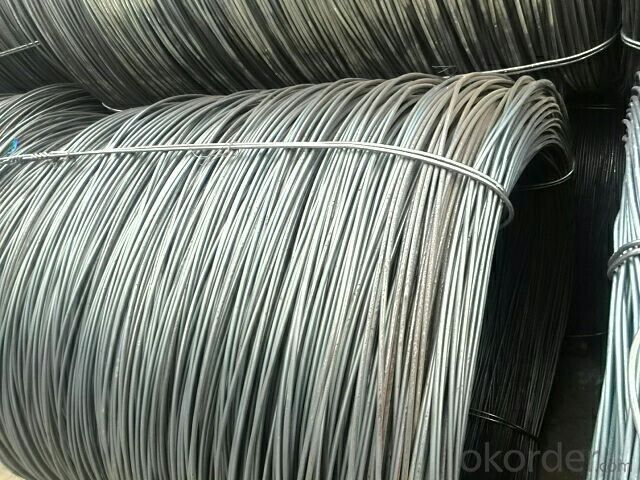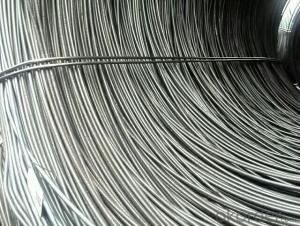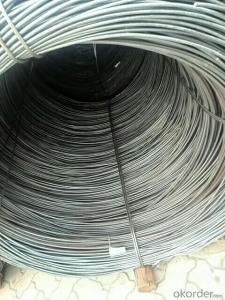Sae1006B+ Sae1008B High quality Wire Rod
- Loading Port:
- Tianjin
- Payment Terms:
- TT OR LC
- Min Order Qty:
- 100 m.t
- Supply Capability:
- 20000 m.t/month
OKorder Service Pledge
OKorder Financial Service
You Might Also Like
Product Description:
OKorder is offering Sae1006B+ Sae1008B High quality Wire Rod at great prices with worldwide shipping. Our supplier is a world-class manufacturer of steel, with our products utilized the world over. OKorder annually supplies products to European, North American and Asian markets. We provide quotations within 24 hours of receiving an inquiry and guarantee competitive prices.
Product Applications:
Sae1006B AND Sae1008B High quality Wire Rod are ideal for structural applications and are widely used in the construction of buildings and bridges, and the manufacturing, petrochemical, and transportation industries.
Product Advantages:
OKorder's Sae1006B+ Sae1008B Wire Rod are durable, strong, and resist corrosion.
Main Product Features:
· Premium quality
· Prompt delivery & seaworthy packing (30 days after receiving deposit)
· Corrosion resistance
· Can be recycled and reused
· Mill test certification
· Professional Service
· Competitive pricing
Product Description:
Specifications of Sae1006B AND Sae1008B High quality Wire Rod :
Steel Grade: sae1006+sae1008B , Standard: GB Diameter: 5.5mm, 6.5mm, 7mm,8mm,9mm,10mm,12mm,14mm
Diameter Tolerance:±0.3mm 6.5mm can be drawing into 2mm/8.0mm can be drawing into 3mm
Brand Name: N-RIVER Place of Origin: Hebei, China Mainland Application: construction, building etc
Chemical Composition:
Please kindly find our chemistry of our material based on Q235 as below for your information
Trademark | Rank | Chemical composition (quality score) % | ||||||
C | Si | Mn | S | P | ||||
| ≤ |
| ≤ | ≤ | ||||
Q235 | A | 0.14-0.22 | 0.30 | 0.30-0.65 | 0.050 | 0.045 | ||
Q235 | B | 0.12-0.20 | 0.30 | 0.30-0.70 | 0.045 | 0.045 | ||
Trademark | Rank | Pulling Test | ||||||
Bend PointΔs/Mpa | Tensile Strength | Elongation Ratioδ5% | ||||||
Thickness (Diameter) /MM | Thickness (Diameter) /MM | |||||||
≤16 | 16-40 | ≤16 | 16-40 | |||||
≥ | ≥ | |||||||
Q235 | A | 235 | 225 | 375-500 | 26 | 25 | ||
Q235 | B | 235 | 225 | 375-500 | 26 | 25 | ||
Usage and Applications of Wire Rod Sae1006B AND Sae1008B :
After hot-rolled the products shaped into coil and delivery as finished product, including round, square, rectangular, hexagonal and so on. Since most of the products are round, it is generally called wire rod. Carbon steel wire rod is widely used in construction and manufacturing. Carbon steel wire rod is mainly used for reinforcement of reinforced concrete and welded structure or reprocessed (roberts , nail, etc.) materials, especially used to produce wire drawing, welding electrode, nails, spring, electronic, precise machinery parts and so on.
Packaging & Delivery of Wire Rod Sae1006B AND Sae1008B :
Packaging Detail: products are packed in coil and then shipped by container or bulk vessel
Each coil weight: 2-3MT
Delivery Detail: within 45 days after received deposit or LC.
Label: to be specified by customer, generally, each bundle has 1-2 labels
Trade terms: FOB, CFR, CIF
FAQ:
Q1: Why buy Materials & Equipment from OKorder.com?
A1: All products offered byOKorder.com are carefully selected from China's most reliable manufacturing enterprises. Through its ISO certifications, OKorder.com adheres to the highest standards and a commitment to supply chain safety and customer satisfaction.
Q2: Can stainless steel rust?
A2: Stainless does not "rust" as you think of regular steel rusting with a red oxide on the surface that flakes off. If you see red rust it is probably due to some iron particles that have contaminated the surface of the stainless steel and it is these iron particles that are rusting. Look at the source of the rusting and see if you can remove it from the surface.
Q3: What is the normal tolerance of Hot Rolled Mild Steel Angle Beams for Structures and for Buildings?
A3: Normally 3%-5%, but we can also produce the goods according to the customers' requests.
Images:


- Q:What are the main factors affecting the price of steel wire rod?
- The price of steel wire rod is influenced by several main factors. 1. Raw material costs: The cost of the raw materials used in the production of steel wire rod, primarily iron ore and scrap metal, play a significant role in determining its price. Fluctuations in the prices of these raw materials can directly impact the price of steel wire rod. 2. Energy costs: Steel production is an energy-intensive process, and the price of energy, particularly electricity and fuel, can greatly affect the cost of manufacturing steel wire rod. Changes in energy prices, such as fluctuations in oil prices or government policies on carbon emissions, can impact the overall price of the product. 3. Supply and demand dynamics: The supply and demand for steel wire rod in the market can influence its price. If the demand for steel wire rod increases while the supply remains constant, prices are likely to rise. Conversely, if there is excess supply compared to demand, prices may decrease. 4. Market competition: The level of competition among steel wire rod manufacturers can impact its price. In a highly competitive market, manufacturers may lower their prices to attract customers, leading to a decrease in the overall price of the product. Conversely, limited competition can result in higher prices. 5. International trade and tariffs: Steel wire rod is often subject to international trade and tariffs. Trade policies, such as import restrictions or tariffs imposed on steel wire rod by governments, can affect its price by limiting supply or increasing costs. 6. Currency exchange rates: Steel wire rod is traded globally, and fluctuations in currency exchange rates can impact its price. If the currency in which steel wire rod is priced strengthens against other currencies, it may lead to an increase in its price. 7. Technological advancements: Advancements in technology used in the production of steel wire rod can influence its price. Newer technologies may result in higher efficiency, reducing production costs and potentially lowering the price of the product. Overall, the price of steel wire rod is influenced by a combination of factors, including raw material costs, energy costs, supply and demand dynamics, market competition, international trade and tariffs, currency exchange rates, and technological advancements. Monitoring these factors is crucial for understanding and predicting fluctuations in the price of steel wire rod.
- Q:How is steel wire rod recycled at the end of its lifecycle?
- Steel wire rod is typically recycled at the end of its lifecycle through a process called steel scrap recycling. This involves collecting the steel wire rod scrap from various sources such as manufacturing waste, construction sites, and end-of-life products. The collected scrap is then sorted and cleaned to remove any contaminants. Next, the scrap is melted down in electric arc furnaces or basic oxygen furnaces to produce molten steel. Subsequently, the molten steel is cast into new wire rod shapes through processes like continuous casting or hot rolling. Finally, the newly produced wire rod is used in various industries to manufacture different products, ensuring a sustainable and efficient utilization of steel resources.
- Q:How is steel wire rod used in the construction of high-rise buildings?
- Steel wire rod is commonly used in the construction of high-rise buildings as it provides strength and durability. It is typically used as reinforcement in concrete structures, such as beams, columns, and slabs, to enhance the overall structural integrity. The wire rod is often formed into mesh or bar configurations, which are then embedded within the concrete to withstand the high loads and forces experienced by tall buildings. Additionally, steel wire rod is also utilized in the construction of pre-stressed concrete elements, which further enhances the building's strength and resistance to bending or cracking.
- Q:What are the common forming methods for steel wire rod?
- The common forming methods for steel wire rod include drawing, rolling, and extrusion.
- Q:How is steel wire rod used in the manufacturing of wire forms for garage doors?
- The manufacturing process of wire forms for garage doors heavily relies on steel wire rod. This essential component acts as the primary material for producing sturdy and long-lasting wires used in the construction of garage doors. To begin with, the selection of steel wire rod is a meticulous process that considers specific qualities like strength, flexibility, and resistance to corrosion. These characteristics ensure that the wires created from the rod can endure the daily tension and stress experienced by garage doors. The manufacturing process commences with the introduction of the steel wire rod into a wire drawing machine. This machine progressively elongates the rod, decreasing its diameter while increasing its length. By repeating this process, the wire is shaped to the desired diameter and length suitable for wire forms. Once the wire has been drawn, it is then molded into various forms crucial for the proper functioning of the garage door. For example, it can be bent or coiled to form springs that provide the necessary counterbalance for the door's weight. These springs are vital to ensure the smooth operation and correct balance of the garage door. Moreover, the wire can also be shaped into cables or tracks that guide the movement of the garage door along its designated path. These cables and tracks guarantee a secure and seamless movement of the door, minimizing any potential damage or accidents. Additionally, steel wire rod is utilized in the creation of reinforcement bars, which add strength and stability to different components of the garage door. These reinforcement bars are strategically placed in areas prone to stress and strain, such as hinges and tracks, to prevent deformation or failure. In conclusion, steel wire rod plays an indispensable role in manufacturing wire forms for garage doors. Its strength, flexibility, and resistance to corrosion make it the ideal material for producing wires capable of meeting the demanding requirements of garage door operation.
- Q:What are the common maintenance practices for steel wire rod?
- Common maintenance practices for steel wire rod include regular cleaning and inspection to remove any dirt or debris, lubrication of moving parts to prevent friction and corrosion, checking for any signs of wear or damage, and storing in a dry and controlled environment to prevent rusting. It is also important to follow proper handling and storage procedures to prevent any bending or twisting of the wire rod.
- Q:How is steel wire rod classified based on its strength?
- The strength of steel wire rod is determined by a grading system called the grade or grade number. This grade number indicates the maximum stress the wire rod can handle before breaking, which is known as its tensile strength. The wire rod becomes stronger as the grade number increases. Steel wire rod is classified based on its strength, with grades ranging from 1000 to 4000. Grade 1000 wire rod has the lowest tensile strength, usually around 1000 MPa, while grade 4000 wire rod has the highest tensile strength, typically around 4000 MPa. Different grades of wire rod are designed for specific industries and applications. Lower grade wire rods are suitable for less demanding tasks like general construction, fencing, and mesh manufacturing. These applications don't require high strength. On the other hand, higher grade wire rods are used in industries that require exceptional strength, such as automotive, aerospace, and the manufacturing of high-tensile steel cables. These wire rods are engineered to withstand extreme forces and are used in critical applications that demand superior strength and performance. In addition to tensile strength, steel wire rod can also be classified based on other properties, including ductility, corrosion resistance, and formability. These properties are crucial in determining the suitability of the wire rod for specific applications. Overall, the classification of steel wire rod based on its strength is vital in choosing the right material for different applications. It enables engineers and manufacturers to select wire rods that can handle the required forces and perform optimally in their respective industries.
- Q:How is steel wire rod tested for reduction in area?
- Steel wire rod is tested for reduction in area by subjecting it to tension until it fractures. The reduction in cross-sectional area at the fracture is then measured and compared to the original cross-sectional area to determine the percentage reduction in area. This test helps evaluate the ductility and strength of the steel wire rod.
- Q:What are the different types of defects that can occur in steel wire rod?
- There are several different types of defects that can occur in steel wire rods. These defects can arise during the manufacturing process or as a result of various external factors. Some common types of defects include surface defects, internal defects, and dimensional defects. Surface defects are often the most visible and can include scratches, pits, cracks, and scale. These defects can occur due to improper handling or storage of the wire rod, as well as issues during the rolling or finishing processes. Surface defects can affect the appearance and functionality of the wire rod and may require further processing or treatment to rectify. Internal defects are defects that occur within the structure of the wire rod and are not visible from the surface. These defects can include inclusions, voids, and segregations. Inclusions are foreign particles that have become trapped within the steel matrix during the manufacturing process. Voids are areas of missing material, while segregations refer to variations in the composition or structure of the steel. Internal defects can weaken the wire rod and reduce its mechanical properties, making it more prone to failure under stress or load. Dimensional defects refer to variations or deviations from the specified dimensions or tolerances of the wire rod. These defects can include variations in diameter, out-of-roundness, straightness, or surface finish. Dimensional defects can occur due to issues with the rolling process, improper cooling or heat treatment, or variations in the raw material used. These defects can affect the suitability and performance of the wire rod for its intended application. It is important to note that the occurrence of defects can be minimized through proper manufacturing practices, quality control measures, and adherence to industry standards and specifications. Regular inspection and testing of wire rods can help detect and address any defects, ensuring the production of high-quality and reliable steel wire rods.
- Q:What are the main factors influencing the choice of steel wire rod order frequency?
- There are several key factors that influence the choice of steel wire rod order frequency. 1. Demand and market conditions: The current demand for steel wire rods in the market plays a significant role in determining the order frequency. If there is a high demand for steel wire rods, companies may need to place more frequent orders to meet customer requirements and maintain inventory levels. Additionally, market conditions such as price fluctuations and availability of supply can also influence the order frequency. 2. Production capacity and lead time: The production capacity of the steel wire rod supplier and the lead time required to deliver the orders can impact the order frequency. If a supplier has limited production capacity or a longer lead time, companies may need to place larger and less frequent orders to ensure a continuous supply of steel wire rods. 3. Inventory management: The existing inventory levels and storage capacity of the company also affect the order frequency. If a company has limited storage space or wants to minimize inventory holding costs, they may choose to place more frequent orders in smaller quantities rather than large bulk orders. 4. Cost considerations: The cost of steel wire rods, including the purchase price, transportation, and any applicable taxes or duties, is another significant factor influencing the order frequency. Companies may analyze the cost of holding inventory versus the cost of frequent ordering to determine the most cost-effective approach. 5. Supplier relationships: The relationship between the company and the steel wire rod supplier can impact the order frequency. If there is a strong and reliable partnership, companies may have more flexibility in adjusting the order frequency based on changing market conditions or business needs. Overall, the main factors influencing the choice of steel wire rod order frequency are demand and market conditions, production capacity and lead time, inventory management, cost considerations, and supplier relationships. Companies need to consider these factors in their decision-making process to ensure a steady and efficient supply of steel wire rods.
1. Manufacturer Overview |
|
|---|---|
| Location | |
| Year Established | |
| Annual Output Value | |
| Main Markets | |
| Company Certifications | |
2. Manufacturer Certificates |
|
|---|---|
| a) Certification Name | |
| Range | |
| Reference | |
| Validity Period | |
3. Manufacturer Capability |
|
|---|---|
| a)Trade Capacity | |
| Nearest Port | |
| Export Percentage | |
| No.of Employees in Trade Department | |
| Language Spoken: | |
| b)Factory Information | |
| Factory Size: | |
| No. of Production Lines | |
| Contract Manufacturing | |
| Product Price Range | |
Send your message to us
Sae1006B+ Sae1008B High quality Wire Rod
- Loading Port:
- Tianjin
- Payment Terms:
- TT OR LC
- Min Order Qty:
- 100 m.t
- Supply Capability:
- 20000 m.t/month
OKorder Service Pledge
OKorder Financial Service
Similar products
New products
Hot products
Related keywords



























